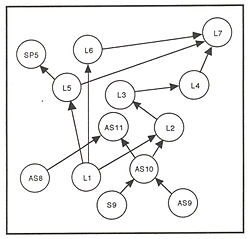- Continuous Progress Mathematics
-
The Continuous Progress Mathematics (CPM) system of multi-age classrooms organizes students into classes based on their immediate instructional level. Implemented at Peach Plains Elementary School in Grand Haven, Michigan, in the fall of 1992, instructional groups called terminals are composed of students who have mastered the critical prerequisites of some 250 objectives within 28 areas of mathematical knowledge. Individual learner mastery of the non-linear hierarchy of mathematical objectives is carefully monitored by teachers and curriculum management software allowing all students to advance through the same curriculum, albeit at different times[1].
Contents
History
Stephen E. Rubin, Ph.D, of Westport, Connecticut, originally designed the hierarchy of mathematical objectives for Center School in New Canaan, Connecticut. Grand Haven Area Public Schools adapted the hierarchy and contracted Tom Orzechowski, systems engineer, to develop a networked DOS version of the management software in the summer of 1992. Kirby Chittenden provided design consultation for the graphical user interface and the software functionality. Additional design support was provided by Melinda Brink, principal of Peach Plains Elementary School, and the school’s math coordinator, Jean Sharp.
Design
CPM was designed around the developmental philosophy that learning is more a function of time rather than ability[2]. Within this design, elementary students leave their homerooms each afternoon to participate in a multi-age instructional group called a terminal. Students flow in and out of these terminals as they are able to demonstrate mastery.
These instructional groups are organized according to two criteria:
- Everyone in a terminal shares a common need to learn the same thing, with the group formed around a specific skill, objective, or outcome; and
- Everyone in a terminal has already mastered the objectives that are prerequisite to learning this new objective.
Classes in various mathematical strands such subtraction (S), decimals (L), statistic and probability (SP) are open and closed as student eligibility increases or decreases respectively. This fluency allows for all students to move through the hierarchy at developmentally appropriate times[3].
Delivery
Teachers often provide a focused whole group instruction based upon one of some 250 objectives available to students. In addition, students may participate in independent or small group activities using classroom manipulatives, learning center activities, cooperative learning groups, peer tutoring, and computer courseware.
Instructors have full latitude to decide what will be used in the way of resources to bring each student to the point of mastery. Not all students achieve success on the same day and in the same way. Level of mastery, rather than rate, is emphasized.
A criterion referenced test allows the student to demonstrate mastery of the terminal objective. The management software then assigns the student to an open eligible class the next day. The software also determines which classes need to open and close based upon student eligibility.
Technology
Early management software, designed to operate on the Apple II platform, did not take full advantage of developments in relational database management. In addition, advancements in object-oriented program language allowed access to information from various sources in a substantially more graphic form. The new management software developed by Tom Orzechowski integrated eight independent databases with the object-oriented characteristics of Borland’s Paradox (database) software development engine[4].
An integral part of Orzechowski’s development process is that of a student’s Locale, or their whereabouts in the hierarchy of mathematical objectives. The Locale (see diagram) provided data about each child’s skill set and functioned as a decision making tool and gateway for enrolling students in appropriate classes each day.
References
- ^ Chittenden, K.L. (1993) Outome based mathematics: A case study in change. Education 695 final project. Grand Valley State University.
- ^ Rubin, S.E. (1990) Public schools should learn to ski: A design for educating in the 21st century. International Journal of Educational Management, 4 (4), 5-17.
- ^ Rubin, S.E. (1993). Resource-based education: It’s like inviting kids to a buffet instead of a sit-down dinner. The New England League of Middle Schools Journal, 6 (1), 8-13.
- ^ Orzechowski, T. (1993) Outcome based curriculum management system. [Computer program]. Grand Rapids, MI: Author.
Categories:
Wikimedia Foundation. 2010.


